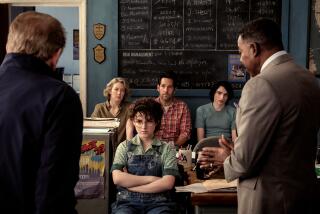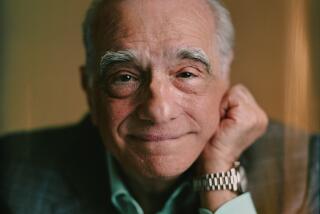‘Christmas Carol’ is a gift that keeps on giving
Ebenezer Scrooge was a heartless miser in desperate need of reinvention. It should come as no surprise, then, that he eventually found his way to Hollywood for numerous makeovers spanning more than a half century.
Charles Dickens reportedly dashed off the story, “A Christmas Carol,” as a way to quickly pay some debts, dreaming up the tight-fisted businessman in 1843. But the writer had more than money on his mind. He was ruminating on heavy issues like consumerism, morality and redemption. He called it “a ghostly little book” to raise “the ghost of an idea.” He did much more than that.
The central concept — three specters guide Scrooge through his past, present and future — has proven irresistible to the creative community. There have been countless remakes of the classic novella across film, TV, theater, opera and radio, with cartoon characters Scrooge McDuck and “The Jetsons’” Cosmo Spacely and British actors Michael Caine and Alastair Sim taking on the title role.
Leslie Bricusse, who wrote the screenplay and original music for the 1970 movie version of “Scrooge” starring Albert Finney, said he was happy to tackle the piece because he’d loved the Dickens tale and its heartfelt message since he was a child.
“It’s all about redemption — that even the worst, meanest person can find a way to see life differently,” Bricusse said recently. “No matter how it’s interpreted — contemporary or period — the eternal truth is always there.”
His iteration of “Scrooge” starred then-34-year-old Finney, at the time the youngest person to ever play the penny-pinching sourpuss. There were other powerful British actors in the mix — Richard Harris, Rex Harrison, Peter O’Toole, Richard Burton — but Finney landed the role during dinner with Bricusse one evening and was on set the next day.
The production, which features elaborate flash mob-style song-and-dance numbers, continued at that break-neck pace. It filmed in about three months in early 1970 and opened at New York’s Radio City Music Hall in November, just in time for the holidays.
There’s been talk of revisiting the project as a made-for-TV movie for CBS, Bricusse said, in light of the resurgent interest in musicals. Songs from the film include the show-stopping ditty, “Thank You Very Much,” and Scrooge’s anti-social ode, “I Hate People.”
In the spirit of the season, here’s a peek at some of the most enduring big- and small-screen adaptations of the iconic Dickens story.
“Scrooge,” 1970
The film, directed by David Lean protégé Ronald Neame, who’d later make “The Poseidon Adventure,” used the versatile Finney as the young and old Scrooge. And without the benefit of digital effects, it made the ghost of Jacob Marley appear to float from scene to scene. It didn’t hurt that the legendary Alec Guinness played that role. A mostly faithful rendition of the original text, this “Scrooge” did add a twist of its own: There’s a spooky descent into hell filled with rats, chains and Lucifer. That scary five-minute bit often gets cut when the movie’s shown on U.S. TV. It’s intact on the DVD.
“Scrooge,” 1951
Often called the definitive Dickens adaptation, this atmospheric black-and-white film stars Alastair Sim as the soulless skinflint headed for rock bottom. Audiences get a peek at his harsh back story — his mother died in childbirth, his father blamed and ostracized him, and he lost his only sister. The British-made film doesn’t dance around the harshness of the original text, lingering on “Ignorance” and “Want,” represented by two scraggly hollow-eyed kids folded into the robes of the ghost of Christmas present. (Some versions omit that scene). Sim’s Scrooge, who goes from bitter and unapologetic to terrified and repentant, laments during his otherworldly journey that he’s “too old to change.” It makes his transformation in the end all the more poignant.
“A Christmas Carol,” 1938
In this modestly budgeted MGM production, Reginald Owen stepped in at the last minute for an ailing Lionel Barrymore as Scrooge. This version is softer and brighter — more Hollywood, if you will — than other interpretations, leading some critics to label it “A Christmas Carol Lite.” Scrooge, for instance, transforms early in the story, shedding his misanthropic ways and embracing the true meaning of Christmas after the first ghostly visit. Why so hasty? Maybe because the film clocks in at a sprightly 69 minutes. Historians have pointed out that the country was still reeling from the Great Depression and on the verge of war, so the filmmakers likely had good reason to smooth out the rough edges. Tip: Go for the original black-and-white, not the colorized version. And see if you can spot a young June Lockhart playing one of the Cratchit kids.
“Mr. Magoo’s Christmas Carol,” 1962
This made-for-TV special with the voice of Jim Backus opened the floodgates for a slew of animated and all-family “Christmas Carols” to follow. Beloved characters including Bugs Bunny, Mickey Mouse and the Muppets later had versions of the literary story. Mr. Magoo’s iteration, with its minimalist animation style and play-within-a-show format, sanitized the classic to make a truly G-rated program. The ghosts aren’t frightening, there are plenty of pratfalls and jokes about Magoo’s poor eyesight, and even the looters who steal from Scrooge are more goofy than sleazy. Music’s from Jule Styne and Bob Merrill, who went on to pen the songs in Barbra Streisand’s “Funny Girl.”
“A Christmas Carol,” 1984
Fans have been going toe-to-toe for years on whether George C. Scott actually made a better Scrooge than Alastair Sim. He did land an Emmy nomination for this made-for-TV movie, but the debate among loyalists — and “Patton” devotees — continues. Scott certainly did embody the role, using that booming baritone to full effect, which made his whispery soliloquies even more moving. And hey, great mutton chops! The supporting cast deserves a tip of the top hat, with character actor David Warner perfect as the put-upon Bob Cratchit and Susannah York lovely as his supportive wife. And as Tiny Tim, a tow-headed Anthony Walters blended just the right amounts of adorable and pitiful without tipping into maudlin.
“Scrooged,” 1988
This comedy, very loosely based on the Dickens text, gives Bill Murray a platform for what he’s always done best: caustic, wacky humor with a heaping dose of vulnerability. In this mish-mash of the classic, directed by Richard Donner, Alfre Woodard stands in for Bob Cratchit, sort of, and Bobcat Goldthwait plays an ousted employee set on revenge. Murray, as a hard-hearted executive of a fictional TV network, cares only about ratings and hypes his station’s live “Christmas Carol” with on-air promos featuring plane explosions and acid rain. (It was the ‘80s.) Carol Kane shines as one of the ghosts and Karen Allen costars as the one who got away. But the film clearly belongs to Murray, who admits, “I was a schmuck!” and then yells, “I get it now!” before leading everyone in a singalong finale.
Bah humbug, indeed.
More to Read
The complete guide to home viewing
Get Screen Gab for everything about the TV shows and streaming movies everyone’s talking about.
You may occasionally receive promotional content from the Los Angeles Times.






